![]()
![]()
![]()
Use LEFT and RIGHT arrow keys to navigate between flashcards;
Use UP and DOWN arrow keys to flip the card;
H to show hint;
A reads text to speech;
96 Cards in this Set
- Front
- Back
|
Kingdom:
Phylum: Class: Order: |
Animalia
Arthropoda Arachnida Acarina |
|
|
Four sub-orders of Acarina
|
1. Ixodoidea
2. Mesostigamta 3. Prostigmata 4. Astimagata |
|
|
Which sub-order of Acarina refers to ticks?
|
Ixodoidea
|
|
|
Body divisions
|
Divided into two parts:
Head: Gnathosoma (i.e. capitulum) Body: Idiosoma |
|
|
Number of legs
|
4 pairs in adult
3 pairs in larvae |
|
|
Wings & Antennae
|
Absent
|
|
|
What kind of parasites are ticks?
|
Obligate parasites
Females and males both need blood meals, but females are heavier feeders |
|
|
Where is most of the life cycle of ticks spent?
|
Off host in environment
|
|
|
Host specificity
|
Variable
|
|
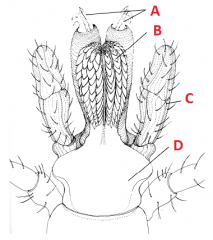
Tick mouthparts
|
A = Chelicerae
B = Hypostome C = Palps D = Capituli |
|
|
Function of palps
|
Feelers
|
|
|
Function of chelicerae
|
Cut the wound
|
|
|
Function of hypostome
|
Jams into the wound and sucks blood
|
|
|
What helps to anchor the tick to its host
|
Backward facing spines on the hypostome
|
|
|
If eyes are present where are they found?
|
Between the 1st and 2nd pairs of legs
|
|
|
Life cycle of ticks
|
Egg
Larva (6 legs) Nymph (8 legs) Adult (8 legs) No pupal stage |
|
|
How can ticks be classified according to its life cycle?
|
One-host tick
Two-host tick Three-host tick |
|
|
One-host tick
|
Remains on host from larva to adult
|
|
|
Two-host tick |
Larvae and nymph feed on one host. Nymph drops off and moults into an adult. Adult finds new host to feed on. |
|
|
Three-host tick
|
Drops off for each moult and finds new host each time
|
|
|
What is feeding timed with
|
Moults
|
|
|
Pathogenic effects of ticks |
Blood loss Irritation, hypersensitivity Damaged hide Reduced growth rate Produce toxins (paralysis) Transmit protozoans |
|
|
Two families of ticks
|
Argasidae and Ixodidae
|
|
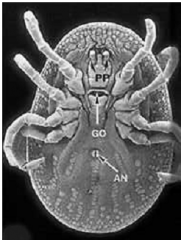
Which family of ticks is this?
|
Argasidae
|
|
|
Argasidae family
|
Soft ticks
No scutum Mouthparts underneathRapid feeders (hours) |
|

Which family of ticks is this?
|
Ixodidae
|
|
|
Ixodidae family
|
Hard ticks
Scutum present Mouth parts anteriorSlow feeders (days) |
|
|
What is a scutum?
|
Plate that the head is attached to
|
|
|
Three types of ticks in the family Argasidae
|
1. Fowl tick
2. "Tampan" ticks 3. Spinose ear tick |
|
|
Fowl tick
|
Argas persicus
|
|
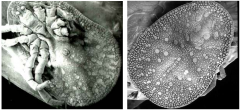
|
Argas persicus
|
|
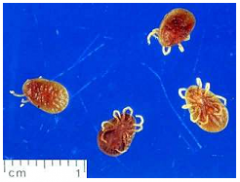
|
Argas persicus
|
|
|
Features of Argas persicus
|
Reddish tick
Mouthparts concealed Distinct patterned margin to body |
|
|
Argas persicus life cycle
|
Egg
Larvae 2 Nymphal stages Adult |
|
|
Where are eggs of Argas persicus laid?
|
In crevices
|
|
|
How long do eggs of Argas persicus take to hatch?
|
3 Weeks
|
|
|
How long do Argas persicus larva feed for?
|
5-10 days
|
|
|
Where does Argas persicus moult?
|
In crevices
|
|
|
How long does each nymphal stage of Argas persicus last?
|
2 weeks
|
|
|
When do adults and nymphs feed?
|
At night (nocturnal)
|
|
|
How long can Argas persicus larvae survive without food?
|
3 months
|
|
|
How long can Argas persicus adults survive without food?
|
3-5 years
|
|
|
Pathogenesis of Argas persicus
|
Anaemia
Irritation Reduced egg production Paralysis caused by larvae (respiratory collapse) Transit Borrelia anserina (tick fever) and protozoan Aegyptianella pullorum |
|
|
Diagnosis of Argas persicus
|
Find larvae on birds or find adults/nymphs in sheds
|
|
|
Treatment of Argas persicus
|
Organophosphate spray or kerosene emulsion
|
|
|
Tampan ticks
|
Ornithodoros moubata, Ornithodoros gurneyi
|
|
|
Features of Ornithodoros ticks
|
Similar to Argas ticks but edge of body is rounded, no sutural line
|
|
|
Where are the two Ornithodoros ticks found?
|
O. moubata - Africa O. gurneyi - Australia |
|
|
Ornithodoros gurneyi
|
Kangaroo tick
Widespread in inland Australia Found under trees where kangaroos camp Feed on kangaroos, dog and man Cause painful swellings and bites Can transmit Q fever |
|
|
Spinose ear tick
|
Otobius megnini
|
|
|
Where is the Otobius megnini found?
|
North America, Africa, recently found in WA
|
|
|
Otobius megnini
|
Adults free living
Larva and nymph live in ears of hosts Hosts: horses, cattle dogs Treatment: ear tags with arthrocidal compounds |
|
|
Classification of the familly Ixodidae
|
Prostriata: anal groove in front of anus
Metastriata: anal groove behind anus |
|
|
Prostriata genera
|
Ixodes
|
|
|
Features of Ixodes
|
Inornate
No eyes or festoons 22 species in Australia |
|
|
4 Important species of Ixodes
|
I. holocyclus and I. cornuatus cause paralysis
I. rubicundus causes paralysis in Africa I. dammini vector of Lyme disease (Borrelia) |
|
|
Life cycle of Ixodes holocyclus
|
3 host tick
Larvae and adults in spring Nymphs mainly in autumn Males rarely found on host |
|
|
How long is the life cycle?
|
18 months (6 months b/n each feed)
|
|
|
Natural host of Ixodes holocyclus
|
Bandicoot and other native animals
|
|
|
Pathogenesis of Ixodes holocyclus
|
All stages cause irritation and paralysis
Paralysis usually seen 5-6 days after attachment of a female Ascending motor paralysis Intense vasoconstriction Die from paralysis of resp. muscles Young children may become ill with odd death reported |
|
|
How does I. holocyclus cause disease? |
Neurotoxin inhibiting transmission of ACh Cardiovascular fraction in toxin causing intense vaso-constriction |
|
|
Which animals are most susceptible to I. holocyclus?
|
Sheep, dogs and cats
Calves and foals are also affected |
|
|
Treatment of I. holocyclus
|
Remove tick
Acaricidal wash Hyperimmune serum to neutralise toxin If tick is removed condition may continue to deteriorate for 1-2days |
|
|
Control of I. holocyclus
|
Wash with acaricidal agent weekly
Examine dogs regularly Pay attention to ears, under collar and between toes |
|
|
Distribution of I. holocyclus
|
Along the east cost of Australia
|
|
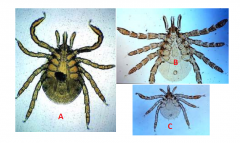
|
Ixodes Holocyclus A = AdultB = Nymph C = Larva |
|
|
Metastriata is divided into two groups what are they?
|
Brevirostrata (short mouth parts)
Longirostrata (long mouth parts) |
|
|
Brevirostrata genera
|
Boophilus
Dermacentor Haemaphysalis Rhipicephalus |
|
|
Boophilus microplus features
|
Inornate
Very short palps and hypostome Palps have ridges Pale legs Eyes present but small Festoons absent Anus hard to see Engorged female has waist |
|
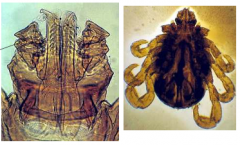
What species is this?
|
Boophilus microplus
|
|
|
What is the common name for Boophilus microplus?
|
The cattle tick
|
|
|
Where is Boophilus microplus found?
|
Occurs in central & south America, South-east Asia
Introduced into northern Australi |
|
|
Hosts
|
Host specific to cattle but occurs occasionally on horses, sheep, dogs & pigs
|
|
|
Lifecycle of Boophilus microplus
|
1 host tick
Eggs hatch Larva climb up grass attach to passing cattle Larva & nymph remain on host Don't spend much time in environment |
|
|
Length of life cycle of Boophilus microplus
|
22 days
|
|
|
Pathogenesis of Boophilus microplus
|
Irritation
Damage to hides Anaemia Anorexia Reduced growth rate and milk production Transmit protozoans: Babesia, Anaplasma, Theileria |
|
|
What are Boophilus microplus numbers controlled by?
|
Low temperature and humidity
Prefer wet tropic weather |
|
|
Dispersal of Boophilus microplus
|
Larvae can migrate in short pasture
Occasionaly be blown up to 30m |
|
|
Host resistance to Boophilus microplus
|
Zebu cattle develop much greater resistance to infection than British breeds
Acquired immunity develops in both breeds Hypersensitivity to saliva develops Mast cells & basophils collect around hypostome Histamine released disrupts feeding, increases reflex grooming Larvae detaches or is removed by grooming |
|
|
Control of Boophilus microplus
|
Use Zebu cattle instead of British breeds Regular dippingPour-ons Pasture spelling Vaccine (Tick-gard) Chemicals: - macrocyclic lactones (expensive) - growth regulators (flurazuron) - amitraz - pyrethroids |
|
|
Features of Haemaphysalis longicornis
|
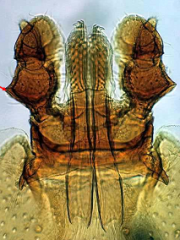
Lateral projections on palps
Inornate Short palps and hypostome No eyes Well defined festoons 3-host tick |
|
|
Common name for Haemaphysalis longicornis
|
Bush tick
|
|
|
Where does Haemaphysalis longicornis occur?
|
Common in SE Asia, introduced into Australia
Occurs in eastern Australia Common in eastern Victoria |
|
|
Hosts of Haemaphysalis longicornis
|
Cattle and other hosts (eg. horses, dogs)
|
|
|
Pathogenesis of Haemaphysalis longicornis
|
Anaemia
Hide damage Vector of Babesia gibsoni of dogs |
|
|
Features of Rhipicephalus sanguineus
|
Basis capituli projects (hexagonal capitulum)
Forked first coxa |
|
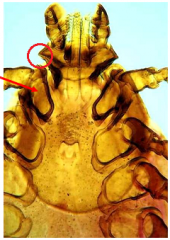
|
Rhipicephalus sanguineus
Arrow points to forked first coxa Circle shows basis capituli projection |
|
|
Common name of Rhipicephalus sanguineus
|
Brown dog tick
|
|
|
Where is Rhipicephalus sanguineus found?
|
Common in tropical countries
Introduced to Australia Common in northern Australia Uncommon but present in Melbourne |
|
|
Pathogenesis of Rhipicephalus sanguineus
|
Anaemia and irritation
Vector of Babesia canis of dogs |
|
|
Longirostrata genera
|
Amblyomma
Aponomma Hyalomma |
|
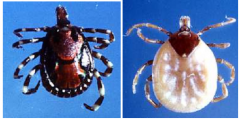
|
Aponomma & Amblyomma
|
|
|
Aponomma & Ambylomma
|
Often brightly coloured
Important on cattle in Africa and USA Most Australian species occur on reptiles Also one on wombat, echidna and kangaroo |
|
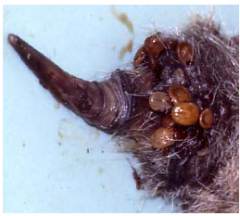
|
Amblyomma triguttatum
(around cloaca of kangaroo) |
|
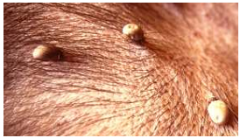
|
Aponomma auruginans
(wombat) |
|
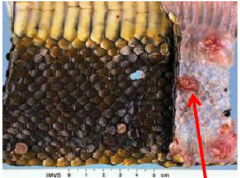
|
Aponomma hydrosauri
(on a snake: note abscesses) |

